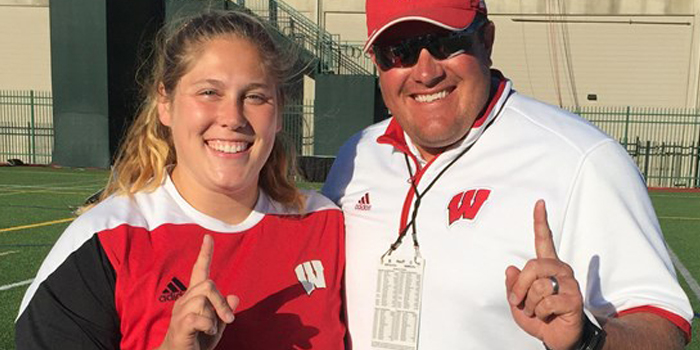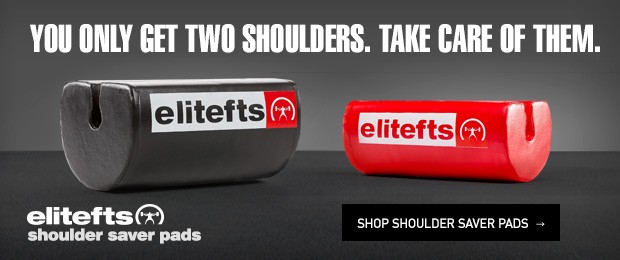
Today I am fortunate to speak with Dave Astrauskas, University of Wisconsin's throwing coach. I have trained numerous throwers these last 13 years at my facility, and I'm always seeking out other methods to use.
Thank you, Dave, for taking time out of your schedule to speak with me.
Tell Us About Yourself
I'm a farm boy originally from Troy, Illinois—a small town 15 minutes east of St. Louis. I went to Eastern Illinois University, where I played football and threw shot, discus, hammer, and weight on the track and field team. In 2001, I graduated with a BS in Biological Sciences and Chemistry. After graduation, I worked as a chemist specializing in new product development in semisolids in the pharmaceutical industry for five years in St. Louis, Missouri. As a pharmaceutical chemist, I started an MBA and a part-time coaching career at Southern Illinois University Edwardsville, thus beginning my pathway into coaching. I enjoyed developing, training, and mentoring athletes. Soon after, in 2005, I was offered a full-time head coach position at SIUE. I moved to Madison, Wisconsin, in 2009 to coach the throws at the University of Wisconsin. Here's more bio information on my athlete's accomplishments.
Macrocycle, Mesocycle, and Microcycle Breakdown
Could you break down your macrocycle, mesocyclone, and microcycle? This will help the strength coaches at almost every level better understand how to train the thrower.
I will talk in generic terms about the training of a shot, discus, hammer, and weight thrower. Due to the nature of the event, the javelin is trained quite differently compared to the other throws.
Macrocycle
The year consists of roughly 48 weeks of strength training and four weeks of active rest. The rest period occurs after the conclusion of each athlete's competitive season. The macrocycle is based around two major peaks for the indoor track and field season and the outdoor track and field season.
We generally only lift two days a week throughout the year because I get a lot of strength gains from just simply throwing. We often throw implements that are 150 percent of the competition weight. If you want sport-specific strength for throwing, throw heavy.
Mesocycle
I have never labeled my mesocycles before, but I would say that I generally have five different types of mesocycles: base, hypertrophy, competition, championship, and recovery.
The Base Mesocycle is a four-week period that occurs just after rest and at the beginning of the school year. At this time of the year, my agenda is simple; I'm trying to build work capacity so that the athlete is able to perform all their throws in a session at a high level. I coach throwers, and ultimately, to improve at throwing you need to do a lot of throwing. Depending on how many throwing events each athlete competes in, I need them to take 40-60 throws in a throws session, or 160-240 throws a week. These strength sessions will contain high volume, an occasional circuit, varying intensity, core lifts, accessory lifts, very few if any Olympic lifts, and very little plyometrics. I've also utilized several variations of Istvan Javorek complexes during this period as well.
During the Hypertrophy Mesocycle, I focus on hypertrophy during summer, mid-fall to winter, and between the indoor and outdoor seasons. I mix it up during this cycle by changing bars, grips, bench angles, and resistance methods. A common four-week block I like to use in this cycle is 5x5, 4x4, 5x3, and 5,4,4,3,2. I also like to use a wave training block around Thanksgiving for four weeks consisting of 8x4x8x4x8, 6x3x6x3x6, 5x3x5x3x5, and 4x2x4x2x4. I will also mix in some six-second isometric work for a set here and there. My goal is to enhance work capacity and build mass.
The Competition Mesocycle is usually four to six weeks and will vary week to week primarily due to off weekends. When I have a scheduled off weekend, I usually up the volume and focus less on bar speed for that week. Sundays are the heavier load days than Thursdays, which primarily focus on speed and ballistic movements. If we travel on Thursday, we will find a weight room to lift in on the road. Usually, as the season progresses, the overall volume of reps decreases. Plyometric work is introduced, and bar speed becomes more important. I try to set up each athlete, so they are ready to compete almost every weekend during this phase.
The Championship Mesocycle is the four-week period where the athlete is preparing for their biggest competitions of the season. Over the four weeks, I program decreased volume, increased weight, increased speed, and removal of accessory lifts. I typically shorten bar movements during this time using box squats, Olympic lifts from hang, board bench, rack lifts, etc. I work in some top-end resistance as well with bands and chains. I choose the set and rep combinations for each athlete, so it is not standard for the entire throws group—everyone is different and responds differently. I also incorporate more plyometric work during this period, such as bounds, box jumps, upper box pushes, assisted jumps, and assisted push-ups. My goal is to produce an athlete that is fresh, at maximal strength, very explosive, and physically and mentally ready to produce a top-end performance.
At the conclusion of the season, it's time for the Recovery Mesocycle to do other things in life than throwing and strength training. I think it is important to get away from typical throws training during this time to avoid burnout. I encourage my athletes to stay active during this time with 20-30 minutes of activity (biking, hiking, playing other sports, etc.) four times a week.
INTERVIEW: Owner of Sports Advantedge Brian Bott
Microcycle
I write my strength training Microcyles in two-week blocks of four total lifting sessions. We lift on Sundays and Thursdays and have Saturdays off in the offseason (fall semester). During the season (spring semester) we lift on Sundays and Thursdays and usually compete on Friday or Saturday, taking Tuesday off. On the days that we are lifting, we don't throw. I usually wait until the conclusion of the last throw session or competition before I write the next two weeks of strength training. I evaluate what I see in the throwing ring and what I see in the weight room to determine exercises and volume. This two-week period is generally very similar in exercise, volume, and intensity. Generally, the two Sundays mirror each other and the two Thursdays are similar as well.
College Scholarships
What information would you give the high school thrower and their coach to help them receive a college scholarship? Anything you look for when recruiting?
To get offered a scholarship, you must first capture the attention of a college coach. First, review the current track and field roster at the desired school and see if your high school performances are comparable to athletes that are currently on the roster. If so, fill out an online questionnaire on the team website and follow up with a brief email introducing yourself to the event coach. Attach a video of a recent performance. This process will allow the college coach to evaluate you and contact you if they're interested.
When I'm recruiting, I look at many different things. Primarily, I look at personality, academics, and athletic ability. First, I feel I have to have some type of connection with the athlete. I spend a lot of time with my athletes and when we are on the same page that is when really big things happen. Second, the athlete must have a very strong academic background to be admissible at Wisconsin. So academics are important and also show me priority, work ethic, and diligence. Athletically, the athlete must first demonstrate something that makes me feel that they can compete in the B1G. (The B1G is arguably the best throwing conference in the NCAA). I ultimately look at how they move in the ring, training age, ankle flexibility, height, weight, posture, wingspan, Q angle, strength, and how they perform in the big meets. Ultimately, if I invest $250k in scholarship money in someone, they better check almost all of the boxes.
Drill Work
If there was just one drill you could do to help the thrower's performance, what would it be?
I wish I knew this magical drill that you speak of! The one drill every thrower should be doing is the drill that addresses the main flaw in their throwing technique. When throwing drills are done correctly, they will deliver balanced body positions that allow the body to perform greater forces, ultimately yielding longer throws. Thus, drill work is paramount. However, drill work requires great attention to detail, focus, and a lot of repetition. I start my fall training exclusively with four to six weeks of drills and drill clusters and continue to program drill work in individual athletes training throughout the year based on what I see in their technique. I also like to get a week of drill work in between the indoor and outdoor seasons.
Thrower Practice
In general, how often should a high school throwing athlete practice their skill? How often should they train in the weight room?
A high school athlete who has aspirations of competing at the NCAA Division I level should complete a minimum of two to three thirty-minute throws sessions a week year-round. I think this volume is enough to keep the athlete familiar with the movements involved to throw. I understand that other sports, climate, facility availability, vacations, etc., can get in the way of full throwing sessions with an implement. However, anyone can perform a wide variety of throwing drills, position work, and footwork in their basement or garage. At the same time, I believe a minimum of two to three hours a week in the weight room is necessary for an athlete looking to compete at the DI level.
I hope this information gives you a peek into what I do at Wisconsin. Throws strength training is unique, and I'm fortunate to have the support of the strength staff here at Wisconsin. Our Director of Olympic Strength and Conditioning, Kevin Schultz, is a good guy and a great coach who has a bit of a throws background. He supports what I do and understands that strength training and throws training must be intertwined in a top throws program.
As a top-ranked super-heavyweight, Chris Janek earned the nickname “Tank.” As a two-time all-state wrestler as well as an all-state, third team all-American football player he received multiple full-ride scholarship offers, choosing to play football for the University of Wisconsin. During his collegiate football career, Janek was a four-year letter winner as well as a two-year starter. He was part of four Bowl Games (two Rose Bowls, in which they won). After college, he furthered his football career with a tryout with the Cleveland Browns and an eight-year career in the now-defunct Arena Football League. He is the owner of Tanks Training Facility in Granite City, Illinois and has devoted himself to multi-ply powerlifting. In 2010, Janek totaled 2660 to win best lifter at the GPC Worlds (in Prague). In 2014, he won first place and best lifter overall at the XPC Finals with a 2725 total.











1 Comment